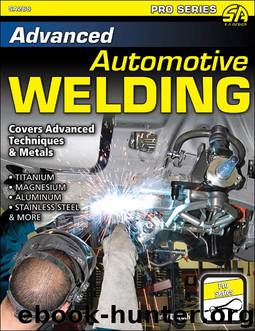Advanced Automotive Welding by Jerry Uttrachi

Author:Jerry Uttrachi [Uttrachi, Jerry]
Language: eng
Format: epub
ISBN: 9781613250969
Publisher: CarTech Inc.
Now for the real test, break the weld open. Place the horizontal plate in a vice and strike the vertical plate with a heavy hammer. Bend the weld away from the unwelded side (see Figure 5.17.) It may take several blows to flatten the vertical member onto the horizontal member. It may require reversing the bent plate and bending it several times to get it to break. Examine the broken weld surface for porosity, lack of fusing to the joint apex, and other defects.
Application: Repairing Cast Iron
Although stick welding is not used often in automotive applications, it’s very effective for repairing cast-iron parts, such as manifolds, differential cases, etc. Braze welding is satisfactory if matching strength is not needed (see Chapter 3). To achieve higher strength, arc welding can be used. However, cast iron is difficult to weld because of its very high carbon content, which can be 10 times the .33 percent in 4130. Most mild and high-strength steels have only .15- to .20-percent carbon.
If a conventional mild-steel electrode is used to weld cast iron, the carbon in the weld deposit is very high, causing very brittle welds that may crack even when using very high preheat. In addition, as the weld shrinks upon cooling, the HAZ is stressed and can crack. There are a number of types of cast iron. The most common is called gray cast iron.
An AWS ENiFeMn-CI electrode can be employed successfully to weld this material. It contains about 42 percent nickel, 11 percent manganese, and the balance mostly iron. Preheating to 600 degrees F can be used primarily to reduce the formation of hard, brittle constituents in the heat-affected zone because the weld metal remains ductile even when diluted up to 30 percent with cast iron. Preheat also reduces the thermal stresses the weld and the HAZ are subjected to when cooling.
The finished welded part should also be slow cooled after welding to minimize stresses. Putting the part in a metal garbage can filled with vermiculite is one way to provide slow cooling. It should be in the can for a minimum of 24 hours. Preheating and slow cooling after welding are particularly useful for complex parts where high-cooling stresses can occur.
Cracks should be opened at a 60- to 90-degree angle to keep the amount of melted cast iron in the weld deposit to less than 30 percent. After preheating the cast-iron exhaust manifold, welding progresses with a 1/8-inch-diameter electrode operating at 90 amps (see Figure 5.20).
Download
This site does not store any files on its server. We only index and link to content provided by other sites. Please contact the content providers to delete copyright contents if any and email us, we'll remove relevant links or contents immediately.
| Automotive | Engineering |
| Transportation |
Machine Learning at Scale with H2O by Gregory Keys | David Whiting(3954)
Never by Ken Follett(3701)
Urban Outlaw by Magnus Walker(3302)
OPNsense Beginner to Professional by Julio Cesar Bueno de Camargo(3225)
Sapiens and Homo Deus by Yuval Noah Harari(2939)
Will by Will Smith(2732)
A Short History of Nearly Everything by Bryson Bill(2574)
Hooked: A Dark, Contemporary Romance (Never After Series) by Emily McIntire(2458)
Rationality by Steven Pinker(2225)
Borders by unknow(2143)
Holy Bible (NIV) by Zondervan(2054)
The Becoming by Nora Roberts(2026)
The One Percenter Encyclopedia by Bill Hayes(1752)
Freedom by Sonny Barger(1741)
HBR's 10 Must Reads 2022 by Harvard Business Review(1736)
A Short History of War by Jeremy Black(1722)
Five Ways to Fall by K.A. Tucker(1665)
Girls Auto Clinic Glove Box Guide by Patrice Banks(1653)
Go Tell the Bees That I Am Gone by Diana Gabaldon(1643)
